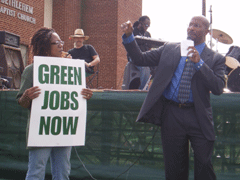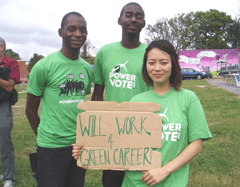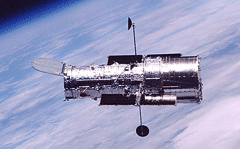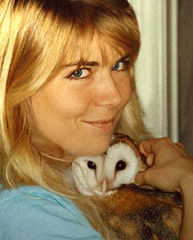October 3, 2008
Air Date: October 3, 2008
FULL SHOW
SEGMENTS
A Green Path out of the Red
/ Jeff YoungView the page for this story
As Washington rescues Wall Street, a growing chorus of big thinkers from the left and right are calling for a greener approach-- using investment in clean energy and efficiency as a way to stimulate the economy. Living on Earth's Jeff Young explores the elements of a green economic bailout. (06:00)
The Clean Tech Challenge
View the page for this story
As Wall Street tumbles, is it taking nascent clean industries with it? Matthew Nordan of Lux Research Inc. says it depends on the industry. Nordan talks with host Bruce Gellerman about green winners and losers and the future of clean technology. (06:00)
A Whale of a Case
View the page for this story
Mid-frequency sonar used by the Navy has been linked to mass beachings of marine mammals, including whales and dolphins. This year, a federal court ruled that environmental precautions must be taken before using the sonar in California. The Navy says that protecting marine animals is coming at the expense of national security and appealed the ruling. The U.S. Supreme Court will soon take up the issue. Host Bruce Gellerman talks with Joel Reynolds, senior attorney and director of the Marine Mammal Protection Project at the Natural Resources Defense Council, about the issue. (06:00)
What Goes Down Comes Around
View the page for this story
According to a recent report, hospitals and long-term care facilities dump up to 250 million pounds of drugs down the drain every year. Ben Grumbles of the Environmental Protection Agency joins host Bruce Gellerman to discuss pharmaceutical flushing and what to do with your dated medication. (04:20)
Canadian Greens Vie for Votes
/ Dan KarpenchukView the page for this story
On October 14th, Canadians take to the polls to choose who will take the reins of the federal government. Elizabeth May of the Green Party of Canada is making inroads with her campaign, despite efforts by other candidates to exclude her from debates. Support for Canada’s Green Party is on the rise but, as Deutsche Welle Radio’s Dan Karpenchuk reports, the jury is still out as to whether that popularity will translate to winning seats in Parliament. (06:20)
Hubble Trouble
View the page for this story
From the delayed Hubble Space Telescope mission to the recent discovery of snow on Mars, astrophysicist Neil deGrasse Tyson, director of New York’s Hayden Planetarium, fills us in on what’s up in space. (07:10)
Girl’s Best Friend
View the page for this story
Wesley the barn owl spent his life as the cherished companion of wildlife biologist Stacey O’Brien. O’Brien chronicles their nineteen years together in her book, “Wesley the Owl; The Remarkable Love Story of an Owl and His Girl.” (10:20)
Show Credits and Funders
Show Transcript
Host: Bruce Gellerman
Guests: Ben Grumbles, Matthew Nordan, Stacey O’Brien, Joel Reynolds, Neil DeGrasse Tyson
Reporters: Dan Karpenchuck, Jeff Young
(THEME)
GELLERMAN: From Public Radio International, this is Living on Earth.
(THEME)
GELLERMAN: I’m Bruce Gellerman. What color is the nation’s financial parachute? Some say it’d better be green.
JONES: Any help anyone gets should have green strings on it to pull us into the only part of the economy that’s going to grow, which is the green part.
GELLERMAN: But opening that green chute will take a Midas’ touch.
NORDAN: It costs a lot of money to be able to build a solar plant or a waste-to-fuel plant, or a water plant. You're going to need tens of millions of dollars, maybe hundreds of millions. That money comes in the form of debt, which requires a credit market. Credit markets collapse, can't build a plant.
GELLERMAN: At least love is free in a time of collapse – a biologist shares her nest with an owl.
O’BRIEN: He moved in with me, so I put him in a little nesting box and he went everywhere with me. Oh it was hopeless – I was completely smitten.
GELLERMAN: A very fine-feathered friendship – and more, this week on Living on Earth. Come along for the ride!
A Green Path out of the Red

[MUSIC: Boards Of Canada “Zoetrope” from “In A Beautiful Place Out In The Country” (Warp Records 2000)]
ANNOUNCER: Support for Living on Earth comes from the National Science Foundation and Stonyfield Farm.
[THEME]
GELLERMAN: From the Jennifer and Ted Stanley studios in Somerville, Massachusetts, This is Living on Earth. I’m Bruce Gellerman, in for Steve Curwood.
With Washington trying to bail out Wall Street with a 700 billion dollar pot of gold, there are those on the left and right who say green is really the way to go, that investments in clean energy and energy efficiency can both stimulate the economy and save the environment. Living on Earth’s Jeff Young reports on what a green bailout might look like.
YOUNG: As the Capitol’s political elite huddled to craft an economic rescue, some other Washington residents in the city’s struggling Anacostia neighborhood rallied for a different kind of economic plan.
CROWD: I’m ready for green jobs now!
[CHEERING, MILLING OF PEOPLE]
YOUNG: It was one of some 700 rallies around the country that day promoting clean energy as a way to generate jobs and wealth. Activist Van Jones, with the Green for All campaign, says that’s where government should be making its investments.
JONES: The people who said we could have a financial strategy based on borrow and spend and bubble and bailout, they’ve had their turn. They’ve been totally discredited. It’s our turn now. Green jobs now! Green jobs now!
YOUNG: Jones says an economic recovery plan should attack many problems at once. If government spending helped idled workers in Anacostia weatherize homes, it would also save energy, cut greenhouse gas pollution and lower utility bills. He calls it greening the bailout.

Green for All activist Van
Jones charges up the crowd in Washington’s Anacostia neighborhood.
YOUNG: It’s not a new idea—Jones has been helping people find work in solar and energy efficiency efforts in the Oakland, California area. And many communities in the windswept states are already at work building turbines for that fast growing energy sector. But as the economy teetered in the past weeks, a green growth agenda really
seemed to gain steam. The opinion pages of the New York Times, Washington Post and other major papers drew parallels between the financial crisis and the climate crisis. And in the latest meeting of the influential Clinton Global Initiative former Environmental Protection Agency director Carol Browner threw out this idea.

College students facing a bleak job market hope green energy investment will brighten the outlook.
YOUNG: Even oil business billionaire T. Boone Pickens, who once bankrolled right wing political attack ads, now buys airtime to encourage renewable energy. When Pickens pushed his energy plan at the National Press Club, he said building a wind energy corridor from Texas through the plains states would boost the flagging economy.
[VOICES AND CLICKING OF DISHES]
PICKENS: Can you imagine how many jobs created in America? Jobs, profits taxes, economy -- America could be revitalized! By just managing our energy properly.
YOUNG: But just how does a bailout aimed at shoring up banks and easing the credit
crunch translate into green jobs? Well, the bailout itself could stimulate green energy by extending tax credits for wind and solar. And some analysts say housing-related assets the government buys could be leveraged to support energy efficient homes. But green jobs author and organizer Bracken Hendricks says the larger opportunities lie in the larger trend we’re now seeing of major government involvement in the markets.
HENDRICKS: We need to be stimulating the businesses and the investments that are really going to improve our productivity by investing in clean energy and renewable energy. And at a time when we are seeing an increasing public role in shoring up financial institutions, this is the time to ask for that sort of a public return on our investment.
YOUNG: Hendricks helped bring business, labor, and environmental groups together in
the Apollo Alliance. He’s now a senior fellow at the progressive policy think tank Center for American Progress. Hendricks thinks Congress will try another economic stimulus package to bring the country out of recession. The last stimulus, you might remember, came in the form of checks straight to taxpayers. Hendricks says a CAP study shows a green stimulus package creates more jobs than just encouraging consumption.
HENDRICKS: That money stays locally—you can’t outsource jobs retrofitting buildings for efficiency or building transit systems. Put aside the environmental benefits. Investing in a green recovery is better economic policy and it puts us on a faster road to recovery.
YOUNG: Hendricks says that would be an attractive option for the next president, no matter who wins in November - both candidates say they support renewable energy. But with the bailout and a slow economy stressing the budget, will the president still be able to pay for large-scale investment? Recent statements from the candidates offer some insight. In the first presidential debate, PBS moderator Jim Lehrer asked Republican Sen. John McCain what he might give up in a tight budget.

Many say a green economy will be a bullish economy.
LEHRER: Spending freeze?
MCCAIN: I think we ought to seriously consider it, with the exceptions the caring of veterans national defense and several other vital issues.
YOUNG: As for spending that might create jobs, McCain said his plan for more nuclear power plants would put hundreds of thousands to work. Democratic Senator Barack Obama emphasized jobs from renewable energy and rebuilding infrastructure. It was a theme he returned to on the Senate floor, just before Wednesday’s bailout vote.
OBAMA: We can¹t wait to create millions of new jobs by rebuilding our roads and bridges and investing in fixing our electricity grid so we can get renewable energy to population centers that need them. These are the priorities we cannot delay.
YOUNG: Just how much energy government puts into growing green jobs could largely depend on how the next president and Congress view clean energy: Is it a luxury to be cut in hard times, or is it part of the way out of hard times?
For Living on Earth, I’m Jeff Young in Washington, DC.
Related links:
- Van Jones and the Green for All Campaign
- The T. Boone Pickens plan for energy independence mixes windpower and natural gas
- Listen to a Living on Earth interview with T. Boone Pickens
- Listen a Living on Earth interview with Van Jones
The Clean Tech Challenge

As the Wall Street chill spurs savings, energy-efficient products like these light bulbs get hotter.
GELLERMAN: Hard times, green job, and the future of renewable energy technologies. Our fate and fortunes depend on taking the right road - or maybe it’s the left. To shed some light on the way forward, we turn to Lux Research and Matthew Nordan. He’s president of the independent firm. It analyzes emerging technologies.
Mr. Nordan, I want to thank you very much for coming into our studios.
NORDAN: Thank you for having me.
GELLERMAN: Get much sleep lately?
NORDAN: Not so much. Not so much. Been a rough couple of weeks.
GELLERMAN: Well, why?
NORDAN: Well, our clients are all chemical companies, private equity funds, other folks that have a vested interest in green technologies rolling out. And it costs a lot of money to be able to build a solar plant or a waste-to-fuel plant or a water plant. If you look at solar, a typical cost is about ten dollars per watt for utility. Which means if you’re gonna build a typical plant, you’re going to need tens of millions of dollars, maybe hundreds of millions. That money comes in the form of debt, which requires a credit market. Credit markets collapse, can’t build the plant.
GELLERMAN: So the clean technologies stocks on Wall Street have really been tanking along with the rest of the street?
NORDAN: Stocks got hammered. You saw that huge decline earlier; again at the same time the average solar stock was down twenty, twenty-five percent. There was a bounce back the next morning, but the impact on these emerging technologies was bigger than the impact on blue chips or the economy as a whole.

Matthew Nordan, president of Lux Research.
NORDAN: I think there are a couple of things. To the extent that credit markets remain constrained, anything that you need debt to deploy, just gets iced. But that doesn’t mean that money in other forms doesn’t continue to flow in energy and environment. It just means that you can’t loan people money, you have to give them money in exchange for ownership of the company. So venture capital is probably just fine. That money is sitting in accounts, it’s already been called down, and those funds are required to spend that money in a certain amount of time. It’s the project finance to build the facilities and do these large scale deployments in things like solar and waste-to-fuel and water that’s going to be hard.
GELLERMAN: So it’s the early stage technologies which might benefit from this because the venture capital, the VC money, is relatively small, short money.
NORDAN: That’s right. And in fact, there are also some cases where you might see some technologies get more investment rather than less now. A good example is demand response, which is deploying sensors which let you turn down your electricity usage when the price of electricity on the grid is highest. If you’re a retail chain looking at that, thinking it might shave a tenth of a percent of operating cost, you probably might not have thought about making that switch beforehand. If you’re facing consumers that are not spending money, same store sales are going down, you probably care a lot more about saving that amount of money.
GELLERMAN: Let’s look at some growth projections for certain slices of the renewables. Solar: up or down?
NORDAN: Well solar, in a base case, where you’ve got access to credit, we think continues to grow about 30% a year, gets from today’s 21 billion to about 100 billion dollars in about 2013. Can’t get access to credit? All that goes out the window, could be flat, could even decline.
GELLERMAN: Wind?
NORDAN: Wind is a little bit different from solar in that it doesn’t depend so aggressively on subsidies in order to be cost competitive. But it still requires tens of millions of dollars to go out and build large-scale plants. Those deployments would get hammered too.
GELLERMAN: I may catch a little flack for this by grouping this in with those, but nuclear?
NORDAN: Well nuclear – remember it takes about thirteen years to permit a nuclear plant in the United States. It takes about three years to build it. So these are so far out, that anybody who is currently in a permitting process for nuclear, is just going to keep steamrolling right on through, because by the time that they get done, it’s very likely that all this will just be a memory.
GELLERMAN: Electric cars?
NORDAN: Electric vehicles is a different case, because to the extent that oil prices remain reasonably high, to the extent that there are reasonable pressures on oil, there’s still gonna be a short term payback for hybrid electric vehicles and for pure electric vehicles. Particularly the commercial kinds, like big buses and trucks that happen to be really intense when it comes to fuel. That’s one area that I think is gonna be more isolated from impact. Certainly gonna get hit, just like anything else if there’s lack of credit, but if money’s gonna flow somewhere, is it more likely to flow to electric vehicles than PV, absolutely.
GELLERMAN: Many economists are anticipating a recession, if not worse now. And with a recession or downturn, you usually have a lessening of demand. Fossil fuel use would go down, the prices would go down, and that would make energy saving technologies, and renewable technologies less appealing.
NORDAN: You’re absolutely right. And since the middle of the summer, we’ve seen the price of oil drop precipitously. There are many people who think that that could reach $80 a barrel by the end of the year. That’s going to be an inhibitor for technologies of all types who basically had their profitability pegged to the price of oil.
GELLERMAN: But isn’t this a critical time for clean energy and clean technology. I mean we’ve got climate change. How do you balance that act?

As the Wall Street chill spurs savings, energy-efficient products like these light bulbs get hotter.
GELLERMAN: So, if you were a betting man, what budding clean tech would you invest in?
NORDAN: I think you’re going to see the investment go into efficiency technologies, things that are replacements or alternatives for what you use now that pay themselves back in a very short amount of time. Things like solid state lighting, LED light bulbs. You’re gonna buy light bulbs anyway, the question is just what kind. And people are more likely to get over the hump of having a big upfront cost in order to buy something if they care more about the savings that comes in the next year and the next and the next in an environment like this one, savings are going to get more important.
GELLERMAN: Mr. Nordan, thank you very much for coming in.
NORDAN: And thank you for having me.
GELLERMAN: Matthew Nordan is president of Boston-based Lux Research.
[MUSIC: Marz “Blaue Faeden” from Wir Sind Hier (Karaoke Kalk Records 2004)]
GELLERMAN: Just ahead, navy sonar and endangered whales -- the Supreme Court hears the case. Keep listening to Living on Earth!
Related link:
Lux Research Inc.
A Whale of a Case

Humpback whales can be heard across oceans. (Photo: Ocean Alliance/Iain Kerr)
[MUSIC: Tom Verlaine: Old Car from Warm And Cool (Thrill Jockey Records 2005)]
GELLERMAN: It’s Living on Earth, I’m Bruce Gellerman.
[HIGH PITCHED SOUND OF SONAR]
GELLERMAN: Hear it?
[SONAR]
GELLERMAN: This is the sound of Medium Frequency Active Sonar.
[SONAR]
GELLERMAN: The U.S. Navy uses this sonar to detect enemy submarines, running silent and deep at sea. This sound is also at the center of a scientific controversy and constitutional struggle that the U.S. Supreme Court confronts as its new term gets underway. Lower courts have ruled against the Navy, which trains sailors in the use of active sonar off the coast of Southern California. The courts say the Navy must take preventative measures to protect whales and other marine mammals from the sound. The Navy says, No, it doesn’t - national security comes first - and the president agrees. Now it’s up to the Supreme Court to decide.
Joining me is Joel Reynolds. He’s senior attorney and director of the Marine Mammal Protection Project at the Natural Resources Defense Council. Mr. Reynolds, let’s take another listen to the Medium Frequency Active Sonar.
[SONAR]
GELLERMAN: You know, Mr. Reynolds, it sounds like a maniacal dentist. It sounds awful.
REYNOLDS: To me it sounds like fingernails on a black board at a very high level. And understand that the sound that you’re hearing is an infinitesimal fraction of the intensity of the actual use of this sonar.
GELLERMAN: Well how does it sound to whales?
REYNOLDS: It’s very hard to say. Whales have a very different sense of sound than human beings do. But what we know is, what we’ve observed in terms of their reaction. They avoid the sound immediately when exposed to it. It has caused in repeated instances, whales to strand and die on the beaches with blood coming out of their eyes and ears and their mouth as the result of internal hemorrhaging. It causes damage to the hearing mechanism. The fact of the matter is that there is an indisputable scientific record of carnage in the wake of the use of this kind of sonar around the world. And the notion somehow that the waters of southern California will be immune from that harm is – is not only ridiculous, but there’s no scientific basis for it whatsoever.
GELLERMAN: So what does the navy’s environmental impact statement - which I guess they’re required to file in a case like this – say about the effects of mid-frequency active sonar on marine mammals?
REYNOLDS: First of all, the Navy didn’t prepare an environmental impact statement in this case, and that’s a violation of federal law. Second of all, they did prepare something called an environmental assessment, and in that document they estimated that over the two-year period of fourteen exercises off the southern California coast they would take an estimated 170,000 marine mammals, including taking some five endangered species of whales that reside off our coast.
GELLERMAN: Now, what is a take?
REYNOLDS: A take is a legal term under the Marine Mammal Protection Act, which encompasses a range of harm from significant disturbance to injury to death.
GELLERMAN: The navy did not file an environmental impact statement?
REYNOLDS: No. And that’s at the heart of the case. They – on the one hand, they claim no harm. On the other hand, their own numbers suggest what the district court called a near certainty of environmental harm. And that’s the box in which the Navy finds itself.
GELLERMAN: So the lower federal courts had ruled in favor of NRDC, basically you, saying there was potential harm, that the navy had to do some mitigation. Then the navy said “No we don’t” and the White House said “You’re right – you don’t.”
REYNOLDS: That’s right. Their position is that for reasons of national security, the laws do not apply to them. That is the principle that is at the heart of this case as it now stands before the U.S. Supreme Court. Our position, and the law going back hundreds of years in this country, is that all of us are subject to the law, so when a court issues an injunction, we have to comply with it. That’s at the heart of our system of government. But the White House has turned that on its head, at the Navy’s behest in this case, and they have essentially concluded that the Navy is not bound by those laws, it’s not bound by the injunction, and it’s asking the Supreme Court to vindicate that point of view.
GELLERMAN: Do you appreciate the Navy’s concern for the potential negative effect on national security? Should the Supreme Court, you know, agree with you?
REYNOLDS: There’s no implication for national security. I mean, that is a myth. In fact, that’s the point of view that the Navy has tried to persuade first the district court and then the Court of Appeals to be correct. But in each case, the courts, after examining all the evidence presented, including evidence of the Navy’s own past mitigation practices, the courts uniformly concluded that there is no significant intrusion on the Navy’s readiness training if they introduce common sense measures to reduce risk.

Humpback whales can be heard across oceans.(Photo: Ocean Alliance/Iain Kerr)
GELLERMAN: Well Mr. Reynolds, thanks a lot. I appreciate your time.
REYNOLDS: My pleasure. Thanks for having me.
GELLERMAN: Joel Reynolds is senior attorney and director of the Marine Mammal Protection Project at the Natural Resources Defense Council.
We asked the U.S. Navy to talk to us. Instead a spokesperson had this statement:
“Submarine warfare is the number one threat facing the Navy today and mid-frequency Active Sonar is the only way to detect and track modern diesel electric subs. The Navy has been using sonar off the coast of Southern California for the past 40 years and has not had a single reported death of a marine mammal linked to sonar.”
Related links:
- Read the U.S. Navy's environmental impact statement
- Natural Resources Defense Council on Whales and Sonar
[MUSIC: Paul Winter “Lullaby From The Great Mother Whale For The Baby Seals” from Callings (Living Music 1980)]
What Goes Down Comes Around

According to officials-- not a trashcan. (Photo: Daniel Greene)
GELLERMAN: Here’s a sound and a statistic that may give you cause for concern.
[FLUSHING SOUND]
GELLERMAN: According to an investigative report by the Associated Press, Americans flush a quarter of a billion pounds of drugs and contaminated packaging down the drain every year. To draw public attention to the problem, the U.S EPA and California named this: “No Drugs Down the Drain” week. Ben Grumbles is the EPA’s Assistant Administrator for Water.
GRUMBLES: There’s growing awareness that the toilet isn’t a trashcan, and that it’s important to protect the environment and properly dispose of unwanted pharmaceuticals.
GELLERMAN: But, in fact, part of the problem is the federal government’s own regulation. It requires that labels on narcotic painkillers tell people to flush unused pills down the drain. Another problem - not all drugs are fully metabolized by the body and are excreted. Still, according to the AP investigative report, most of the 250 million pounds of pharmaceuticals going down drains comes from the nation’s hospitals and long-term care facilities. Whatever the source, the EPA’s Ben Grumbles says, the drugs can eventually wind up in our drinking water:
GRUMBLES: For decades, pharmaceuticals in very tiny trace amounts have been sent to wastewater plants and may also appear in lakes and streams at extremely small amounts in the parts per trillion.
GELLERMAN: Well these amounts as you note are in minute concentrations, but these are some very toxic and very powerful drugs. I mean you have anti-cancer drugs, you have antibiotics, you’ve got drugs that mimic hormones – in fact, drugs that are hormones.
GRUMBLES: Well, we know several things. One is that in therapeutic doses, those types of contaminants could pose a risk to the environment, to fish and wildlife, which can be very sensitive. We are very concerned about potential impacts on aquatic life. We know enough, we have enough information, to know that there are actions we can take. And one very important action we’re taking is to significantly expand the scope of the science and the surveys to see just how much of these tiny, truly tiny trace amounts are in the environment. But the really key part is to get new information, as much as we can, on whether there are any risks to human health. And the most important thing right now is to be spreading the word about proper disposal of pharmaceuticals. The toilet is not a trashcan. And also working with communities providing grants or outreach and awareness programs so that there can be community collections, take back programs for unused and unwanted pharmaceuticals.
GELLERMAN: I know that there is a pilot takeback program. Where is it?
GRUMBLES: We’ve got several across the whole country. About three or four months ago, EPA working with states and cities across the Great Lakes region conducted a massive take back program for pills which netted millions and millions of pills that might have otherwise entered into the environment through toilets or through sewer systems.
GELLERMAN: It was coincidental, but just this morning I was going through some old pills that I had in my medicine cabinet and thinking, you know, what do I do with these things?
GRUMBLES: Well, based on our guidance right now, I would say a couple things. One is don’t flush it down the toilet. The other approach is to secure it in the trash and mix it with unwanted or – kitty litter or coffee grinds. We also are looking at incineration as one other mechanism for the waste that does get taken to a landfill or separating it out. We’re looking at reverse distribution systems – that’s kind a term of art that’s meant to help encourage the return of unwanted or unused pharmaceuticals either to the pharmacies or from the pharmacies to the actual manufacturers for proper disposal, which may mean incineration.

(Photo: Daniel Greene)
GRUMBLES: Thank you very much. Thanks for your great questions and we’ll stay in touch. Thank you.
GELLERMAN: Ben Grumbles is the Assistant Administrator for Water at the U.S. EPA.
[MUSIC: Jacob Fred Jazz Odyssey “Tether Ball triumph” from Lil Tae Rides Again (Hyena records 2008)]
Canadian Greens Vie for Votes

Green Party of Canada candidate Elizabeth May. (Courtesy of Green Party)
GELLERMAN: The environment is shaping up as the number one issue in the upcoming election - Not the U.S. election, perhaps, but Canada’s. On October 14th, Canadians go to the polls to choose a party to lead the nation. In two televised debates, climate change, energy and carbon taxes were discussed by leaders of five political parties, which for the first time marked the inclusion of a Green Party candidate.
Mainstream political parties had tried to prevent the Greens from participating, but as Dan Karpenchuck of Radio Deutsche Welle reports from Toronto, public outcry led to the inclusion of the Green candidate Elizabeth May.
MAY: To all of you who are disenchanted, dispirited, disappointed and disillusioned, this is the time for you to wake up and recognize that the leadership does not exist at the series of podiums you just watched over this morning. The leadership is the people of this country, because in a democracy the people are in charge.
[APPLAUSE]
KARPENCHUCK: Elizabeth May launches a passionate opening to her election campaign. She’s the leader of Canada’s Green Party. Although she didn’t have a seat in the last Parliament, she’s fighting personally for a Nova Scotia riding held by Conservative heavyweight Peter MacKay. But almost from the beginning of the campaign, the old boys in politics closed ranks in a bid to prevent her from taking part in a televised leadership debate. Prime Minister Stephen Harper told the major networks that if May is there, he wouldn’t be. He said she is really a Liberal and he does not want to face two liberals in the debate. Only Stéphane Dion, the liberal leader and an admirer of May’s said that she should be included in the televised debates. May herself was nonplussed. Tough and ready to scrap with her opponents in any forum, May is certain that she will be representing the Greens at the debates.
MAY: I think I’ll be in the debates, and I think I’ll leave it at that. I have a sense of the dignity of Greens across Canada and the importance of our policies and our ideas. I’m not a protester. I’m a leader of a federal political party that’s represented in the House of Commons and I have a right to be in the debates.
KARPENCHUCK: In the end, after a groundswell of public support for May through letters, emails, and people of all parties phoning in to talk shows, the prime minister and other naysayers changed their tune. There may be some fear there among the main parties who have held influence in Canada for decades. Polls suggest that many voters are considering the Greens as a viable choice for their votes. And even though the party will not form a government any time soon, there’s a possibility of it winning several seats.
[SOUND OF JET]
KARPENCHUCK: Oshawa is a small city on the outskirts of Toronto. It’s been a key battleground in the past between the Conservatives and the Liberals. It contains one of the biggest private sector employers in the country: General Motors builds cars and trucks here. But thousands of workers have lost their jobs over the past several years. GM is one of the many manufacturers in Ontario, the country’s economic engine, to be bleeding red ink. Here in Ontario, unemployment takes center stage in this election. The Greens are hoping that their idea that their environmental policies can provide jobs will persuade these voters to go green. And they’re hoping that Elizabeth May can bring them around.
[PHONES RINGING]
GOSLIN: Pat Goslin. Hi Mike. I was just talking to ….
KARPENCHUCK: Pat Goslin is a Green Party candidate here in Oshawa.
GOSLIN: I believe that the bottom line is the environment. And the economy goes hand in hand with that. There’s a future in green jobs. Green jobs are sustainable. There’s telecommunication technology, future pharmaceuticals especially with the aging population. Green vehicles, electric vehicles, hybrid vehicles and an increase in public transit that is necessary to reduce the carbon output.
KARPENCHUCK: Goslin is a retired schoolteacher who has campaigned for the Liberal Party. But she says Elizabeth May and her passion for the environment is one of the reasons that she herself is now a candidate for the Green Party.
GOSLIN: She’s amazing. She’s my personal hero. I’ve been reading her book on how to save the world in fifteen minutes. And she is very, very inspiring.
[SOUND OF VOLUNTEERS TALKING]
KARPENCHUCK: A few of the volunteers drift in to the campaign office to join Goslin. They’ve been out in teams putting up Green Party signs. The atmosphere here is relaxed, easy going. Joan McKnight is the campaign manager. She’s worked for the Liberals and the Conservatives in the past. Now McKnight says she too has been inspired by Elizabeth May, and she says it’s astounding the number of calls she’s getting from people, and visits from those who walk in to find out more about the Greens, young people, nonwhites, those from other political parties looking for change, and now even senior citizens frustrated with the mainstream parties.

Green Party of Canada candidate Elizabeth May. (Courtesy of Green Party)
KARPENCHUCK: In the last election, the Green Party captured about five percent of the vote. The latest polls put the greens at more than double that number, at about 11%. Many Canadians are concerned about the environment and climate change and are unhappy with the environmental policies offered by the old parties. Virginia Ervin is twenty-four years old. She’s been a Greens candidate in the past two elections, but she’s decided to sit this one out, preferring to work behind the scenes and help organize.
ERVIN: They have rallied the troops. We’ve invested our time, we’re getting out, we’re meeting people, we’re shaking their hands, we’re telling them what being Green is. And they’re enjoying what they hear.
[SOUND OF TRAIN LEAVING STATION]
KARPENCHUCK: Meanwhile, Elizabeth May recently began a campaign tour by train, opting for a more green approach unlike the aircraft used by her political opponents. On her whistle-stop tour, she’ll unveil the Green Party of Canada’s promises to the Canadian people which include a guaranteed livable income supplement for the poor, more money for research grants that focus on renewable energy and conservation, shift consumption taxes to environmentally harmful products and services away from income and products, and cut corporate taxes for each ton of carbon emission reductions. Of course she hasn’t said what this will all cost. The other leaders have backed up their claims with figures. So May will still have to prove herself to voters and make her case.
[TRAIN SOUNDS]
KARPENCHUCK: Dan Karpenchuck, Toronto.
GELLERMAN: Our story about Canada’s Green Party comes to us courtesy of Radio Deutsche Welle.
[MUSIC: Dirty Dozen Brass Band “Mercy, Mercy ME (the Ecology) from What’s Goin On (Shout Factory Records 2006)]
GELLERMAN: You can hear our program anytime on our Web site, or get a download for your mp3 player. The address is loe.org. That’s l-o-e dot o-r-g. There you’ll also find pictures and more information about our stories. And we’d like to hear from you. It’s comments@loe.org, that’s comments at l-o-e dot o-r-g. Our postal address is 20 Holland Street, Somerville, Massachusetts, 02144. And you can call our listener line at 800-218- 9988. That’s 800-218-99-88.
Coming up: Things that go bump in the night: An owl and a biologist - a love story. It’s a hoot. Stay tuned to Living on Earth.
ANNOUNCER: Support for the Environmental Health Desk at Living on Earth comes from the Cedar Tree Foundation. Support also comes from the Richard and Rhoda Goldman fund for coverage of population and the environment. And from Gilman Ordway for coverage of conservation and environmental change. This is Living on Earth on PRI, Public Radio International.
Related links:
- Green Party of Canada
- To learn more about Elizabeth May, read her biography
- Deutsche Welle Radio's Living Planet
[MUSIC: “All Apologies” from Then and Now: The Definitive Herbie Hancock (Verve Records 2008)]
Hubble Trouble

The Hubble Space Telescope has been in orbit for 18 years. (Courtesy of NASA)
GELLERMAN: It's Living on Earth, I'm Bruce Gellerman.
The Hubble’s in trouble. For the past eighteen years the giant space telescope has been orbiting the earth, revealing images of deep space and distant time. But the aging observatory has problems. A shuttle mission to update equipment on the telescope was supposed to launch this week, but the flight has been delayed until sometime next year. It seems technicians discovered a faulty data link aboard the Hubble, making the shuttle trip useless till that problem’s fixed.
So far the Hubble project has cost upwards of ten billion. Have we gotten our money’s worth? Well, when things turn celestial, we turn to Neil DeGrasse Tyson. He’s director of the Hayden Planetarium in New York City - and he says, Hubble’s payback has been out of this world.
TYSON: I would say Hubble wears two hats. One of them is the “Look how cool the universe is” hat. And in that capacity, it produces these gorgeous color images that we all know and love. We’ve all downloaded and put on our screensavers on our computers. And so it brought the universe into our collective backyard. It’s kind of an ambassador to the cosmos. The other hat is simply its scientific discoveries, one of which was it gave us the first accurate estimate for the age of the universe – about 13.7 billion years.

A helix nebula recorded by the Hubble Space Telescope—often referred to as "the eye of God." (Courtesy of NASA)
GELLERMAN: Space Exploration Technology, a private company, just was able to launch the first private payload into orbit. Big deal, huh?
TYSON: Yeah - Yeah, actually, if you’re in the circle we called them Space Ex. That’s a whole new way of getting into orbit, new in the sense that one is not relying on government spacecraft or the economy of cost that is associated with government spending versus corporate. So the whole point of Space Ex is to try to reduce the cost of access to space.
GELLERMAN: But the cost of putting a pound in orbit has pretty much stayed the same these many years.
TYSON: Yeah it has. It varies depending on what is your technology to do it. The shuttle turned out to be vastly more expensive than anyone had hoped for. Because part of it is not simply what it costs to launch a vehicle. There’s a whole other aspect to the cost of launch, and that is what is the cost of the system that produces the launch vehicle itself. The factories, the employees - all the rest of that. And some of those are just simply fixed costs, and if you launch only once a year or twice a year those huge fixed costs get divided into only a couple of shuttles. And so it doesn’t work out yet until you start launching at a very regular rate.
GELLERMAN: So this per launch rate is sort of like Netflix – you know, the more you order –
[LAUGHING]
TYSON: Exactly. The more you do it the cheaper per viewing it is, per launch it is. That’s the exact model right there.
GELLERMAN: I wanted to ask you about my favorite spacecraft, the Phoenix Mars Lander.
TYSON: Oh yeah.
GELLERMAN: Just discovered that there’s snow on Mars. What does snow on Mars mean?
TYSON: Well, what I like about the snow is that it means the ice is not just locked somewhere, it’s not just buried in a permafrost which – we’re pretty sure that where most of the water that was once on Mars is now kept -“kept” sounds like aliens are keeping it there - where it’s now found. The fact that you have precipitation, tells you that there are cycles of water. And any time you have cycles, you have occasions to explore with different kinds of chemistry. And chemical explorations are just the kinds of things that can spawn life. You can get different kinds of molecules doing different things under different circumstances. And therein is the chemical experimentations that we’re pretty sure led to life here on earth.

Neil deGrasse Tyson, director of New York's Hayden Planetarium. (Courtesy of
Patrick Queen, reprinted with permission of Prometheus Books)
TYSON: My one question – and I’m not alone with this question, I don’t claim unique thinking here. I wanna know whether or not we are alone in the universe. And that takes more evidence than fuzzy photos of lights in the sky. If somebody’s out there, have ‘em come down here, land in Times Square, come out and shake everybody’s hand. There you go. That’s my evidence. That’s the evidence I’m looking for. One thing I really worry about is whether that’s happened already, but nobody noticed because in Times Square everyone looks really weird.
[LAUGHING]
TYSON: That’s one of my great concerns. But, you gotta wonder that. If they’re out there, what have they learned about the universe that we have yet to discover. How much smarter than we are they and what can they share with us? It could be that it’s possible to become so smart that you invent all kinds of clever ways to kill yourself and to kill others and that it’s a self-limiting process. There’s a limit to how smart a civilization can be because they’ll just kill themselves.
[LAUGHING]
TYSON: So, there’s all these ways of thinking. A lot of it is sort of anthropic because we know we’re capable of killing ourselves ten times over, so surely they would be able to do the same. I’ve got another worry. Here we are on earth. Other than plants, every other life form on earth has to kill something in order to survive. All food you’ve ever eaten except for salt was once alive. Right? Now, that’s in a way, kind of barbaric given the sources of energy freely available on the sun.

The Hubble Space Telescope has been in orbit for 18 years. (Courtesy of NASA)
GELLERMAN: When you look into space and you see the first star at night, do you make a wish?
TYSON: Ah, no. Because I know that the first star you see at night is usually a planet, and so I’m not fooled by that.
[LAUGHING]
TYSON: The planets are brighter than the stars.
GELLERMAN: Next thing the tooth fairy is going to be under attack by you.
TYSON: Ah, no. So most people who wish upon a star, are wishing upon planets and, see, that’s why their wishes aren’t coming true.
GELLERMAN: That’s great. You’re awesome, Dr. T. Thank you.
TYSON: No, the universe is awesome, I’m just your conduit to the awesomeness.
[LAUGHING]
GELLERMAN: Neil DeGrasse Tyson, director of the Hayden Planetarium in New York City.
Related links:
- Neil deGrasse Tyson's website
- Hayden Planetarium
- Hubble Space Telescope Website
[MUSIC: Easy All-Stars “Us And Them” from Dub Side Of The Moon (Easy Star Records 2003)]
Girl’s Best Friend

Stacey and a young, fuzzy Wesley. (Photo: Wendy Francisco)
GELLERMAN: Here’s a sound only a mother could love.
[OWL SOUNDS]
GELLERMAN: A mother…barn owl, that is.
[OWL SOUNDS CONTINUE]
GELLERMAN: It’s also a sound Stacey O’Brien loves. Stacey O’Brien loves a barn owl. She’s a wildlife biologist, who adopted a baby barn owl named Wesley. For nineteen years, woman and bird shared an apartment, and a life, which she chronicles in her new book, “Wesley the Owl: The Remarkable Love Story of an Owl and his Girl.” Stacey O’Brien joins me from public radio station KUCI in Irvine, California. Hi, Stacey.
O’BRIEN: Hi.
GELLERMAN: Let me ask you to start with a reading from your book. Page 204 starts with “throughout our years together.” You see it?
O’BRIEN: Yeah. “Throughout our years together, we had a cuddle ritual almost every night before bed. I would scoop him up with one hand cupped under his tummy, then cradle him in my left arm with his head resting in my hand. One evening, however, as I was lying down and rubbing him under his wings, Wesley pushed with his feet, so that he was lying on my chest with his head up under my chin. Then, he rustled a bit, and slowly began to open both delicate golden wings, stretching them as far as they would go and laying then across my shoulders. He slept that way for a long time, and I stayed awake in awe.”
GELLERMAN: A cuddling ritual.
O’BRIEN: Yes. Unheard of.
GELLERMAN: But you know, Stacey, I think some people hearing this would say “that’s one strange bird” and they might not be talking about Wesley.
[LAUGHING]
O’BRIEN: Well, you know, in the wild, Wesley would have done that with his mate. And they’re extremely affectionate in the wild. So he was doing what he would do in the wild naturally. So what I was trying to do was provide him with an experience as close to what would be natural as possible.

Wesley. (Photo: Stacey O’Brien)
O’BRIEN: He was my son. He was my baby. He was my little boy. But not in a condescending way. He was also my equal, because he was another species, another intelligent life form. And I respected his culture, and he respected mine.
GELLERMAN: I want to back up just a little bit. You met Wesley when he was just an owlet. You were working at Cal Tech as a biologist, and Wes was just a little tiny owl and he had a bum wing.
O’BRIEN: Yeah, he was just a little – about three or four days old, and a hiker found him apparently, down under a nest and brought him into Fish and Game. And when they find an unreleasable animal, they have a hard time placing it – any wild animal. Because all the facilities are pretty full. Zoos are full, rehab centers are full. So sometimes they would bring owls like that to Cal Tech because we had the facilities. We had big, beautiful facilities for owls. But this guy needed to be raised like an infant. So they asked me to take over his care for the rest of his life, and I did. He moved in with me. So I put him in a little nesting box, and he went everywhere with me. Oh. It was hopeless. I was completely smitten.
GELLERMAN: Now, when I hear you talk about Wes, I’m wondering, are you projecting your emotions, human emotions onto this animal.
O’BRIEN: Well, you know, that’s one thing that behavioral biologists used to worry about more than they do now. Of course, I have my own emotions about Wesley. But, I also knew a heck of a lot about barn owls already. So I knew what he would need. And in the wild, they can become very attached, first to their mother and then to their mate. So that was normal for him. He was very emotional about me. And for him to have a good experience of life, as he would in the wild, he needed an emotional connection, just like a human would.
GELLERMAN: Barn owls aren’t pack animals, they’re not members of a flock. They’re loners and they do mate for life.
O’BRIEN: Yes. So there are some really specific problems that come with that. So we’re used to the sort of social interactions where you would correct someone else, like a wolf will snap at another wolf and say, “stop that,” you know? And the other wolf will understand that it’s a correction.

(Photo: Stacey O’Brien)
GELLERMAN: There are a lot of myths about owls. There’s one in France I saw, it says that an owl can help a woman find a husband.
[LAUGHING]
O’BRIEN: Well, it didn’t work that way for me.
[LAUGHIN]
GELLERMAN: No, I was going to say – you know, Wesley did just the opposite.
O’BRIEN: Yes he did.
GELLERMAN: He was jealous when you would bring a boyfriend in.
O’BRIEN: Well for one – in one way he was a good litmus test, because I was surprised that some guys were jealous of him and were threatened by him. And I thought that was so childish, you know. So, immediately they were out the door, you know. Forget it. I don’t want this kind of childishness.
GELLERMAN: But my question is, was Wesley jealous of your boyfriends?
O’BRIEN: He seemed to accept that I had friends in my own species. It confused him. But he seemed to sense instantly if the guy didn’t like him. Again, anything that seemed aggressive, he thought was a threat on my life too.
GELLERMAN: What did you think? You say he was your son.
O’BRIEN: Yeah, I didn’t see him as a mate, of course. I’m a regular human being.
[LAUGHING]
O’BRIEN: You know, I don’t look to a bird for ….
[LAUGHING]
GELLERMAN: You recorded Wesley, right?
O’BRIEN: Yes, I put a lot of effort into trying to record his various sounds. When he decided to make me his mate, he started up with this rocking the house, extremely loud sound, that just vibrated the walls. Eventually, I was able to get that on tape because he did it every single day from then on. It was his way of calling me to come spend time with him. Would you like to hear it?
[WESLEY’S CALL]
GELLERMAN: Oh yeah, sure.
[CALL CONTINUES]
O’BRIEN: That is his nesting call. He’s trying to call me. And boy, you know, that’s a loud sound. It rockets out through the forests and out through the canyons. And if he doesn’t have a mate, it will call a female to him. So it serves a dual purpose. If he has a mate, she’ll come to be with him. If he doesn’t have a mate, he will find one that way. And he found many, many females that way that came directly to our bedroom window and hovered at the bedroom window looking in to see if he was a lone owl or mated owl.

Stacey and Wes. (Photo: Wendy Francisco)
O’BRIEN: I would go to him because the sound was so loud.
GELLERMAN: You didn’t chirp back, did you?
O’BRIEN: No, I talked English, and he spoke owl. You know, he had his – and that’s a whole other subject, actually you know. I would go to him and speak in my language, never expecting that he was actually learning what I was saying in different situations and then eventually understanding almost everything I said. And then, the really surprising thing was that he started to develop his own variations of each of his normal owl sounds that would mean specific things. He had, for example, about twenty variations of the natural begging sound. And they were specific for certain things like one meant he wanted – he was begging for a magazine. He liked to rip up magazines. Another one meant he was begging for water. So, anyways, he developed his own language system, and he made that leap across from understanding what I was doing with symbolic language, I think, to creating his own symbolic language, with his own owl sounds.
GELLERMAN: I know that you brought another sound with you. What is that?
O’BRIEN: This is a sound that, when I recorded it, it had never been recorded by a biologist or noted by a biologist, and it was Wesley’s mating sound, when he was mating. Not the mating call to bring a mate, but the sound he made when he was actually mating with me.
[WESLEY’S MATING SOUND]
GELLERMAN: I gotta ask you, Stacey, when he was giving his mating call, what were you doing?
O’BRIEN: You mean when he was mating with me?
GELLERMAN: Yeah.
O’BRIEN: Aacch, well there was no hope. I mean, it – and this is – I’ve talked to other people who have an imprinted bird with the same problem – you cannot, you cannot fight them off. I mean, if they want to mate with – they’ll pick a place on like your hat or they’ll – or your shoulder.

(Photo: Stacey O’Brien)
[LAUGHING]
GELLERMAN: We’re not giving the book away if we say that Wes dies after 19 years. What now? Is there another owl in your life?
O’BRIEN: I would like there to be. That’s my goal, really. But I would require another permit, because my permit was just for Wesley, for one owl.
GELLERMAN: Stacey, as I was reading your book I was thinking, is this woman nuts?
O’BRIEN: Oh no.
[LAUGHING]
GELLERMAN: Well, and then – as I’m reading the book, I come to kind of understand this unique relationship.
O’BRIEN: Really? Oh good, well I’m glad you understood it because I don’t want to come off like a strange bird. Because I’m perfectly normal. I mean – well – that’s why I put the day in the life of a biologist in there. This is not even that wild, you know, compared to the monkey guy or the spider guy or the guy with the parasites in his skin, you know? I didn’t have parasites in my skin. I thought I was doing pretty good.
[LAUGHING]
GELLERMAN: Well Stacey, I really enjoyed talking with you. Thank you very much.
O’BRIEN: Thank you.
GELLERMAN: Stacey O’Brien’s new book is called “Wesley the Owl: The Remarkable Love Story of an Owl and His Girl.”
[MUSIC: Blue Aeroplanes “Owls” from Bop Art (Setanta Songs )]
Related link:
To learn more about Stacey and Wesley, click here
GELLERMAN: Living on Earth is produced by the World Media Foundation. Our crew includes Ashley Ahearn, Bobby Bascomb, Eileen Bolinsky, Ingrid Lobet, Helen Palmer, Mitra Taj and Jeff Young, with help from Sarah Calkins and Marilyn Govoni. Our interns are Sandra Larson and Jessie Martin. Jeff Turton is our technical director. Alison Lirish Dean composed our themes. Steve Curwood is our executive producer. You can find us at loe.org.
I’m Bruce Gellerman. Thanks for listening.
ANNOUNCER: Funding for Living on Earth comes from the National Science Foundation, supporting coverage of emerging science, and Stonyfield Farm: organic yogurt and smoothies. Stonyfield pays its farmers not to use artificial growth hormones on their cows. Details at stonyfield.com.
Support also comes from you our listeners, the Ford Foundation, the Town Creek Foundation, the Oak Foundation supporting coverage of climate change and marine issues; the Skoll Foundation, supporting social entrepreneurs around the world – uncommon heroes dedicated to the common good. Learn more at skoll.org; and Pax World Mutual Funds: socially and environmentally sustainable investing. Pax World: for tomorrow. On the web at paxworld.com.
ANNOUNCER2: PRI, Public Radio International.
Living on Earth wants to hear from you!
Living on Earth
62 Calef Highway, Suite 212
Lee, NH 03861
Telephone: 617-287-4121
E-mail: comments@loe.org
Newsletter [Click here]
Donate to Living on Earth!
Living on Earth is an independent media program and relies entirely on contributions from listeners and institutions supporting public service. Please donate now to preserve an independent environmental voice.
NewsletterLiving on Earth offers a weekly delivery of the show's rundown to your mailbox. Sign up for our newsletter today!
 Sailors For The Sea: Be the change you want to sea.
Sailors For The Sea: Be the change you want to sea.
 The Grantham Foundation for the Protection of the Environment: Committed to protecting and improving the health of the global environment.
The Grantham Foundation for the Protection of the Environment: Committed to protecting and improving the health of the global environment.
 Contribute to Living on Earth and receive, as our gift to you, an archival print of one of Mark Seth Lender's extraordinary wildlife photographs. Follow the link to see Mark's current collection of photographs.
Contribute to Living on Earth and receive, as our gift to you, an archival print of one of Mark Seth Lender's extraordinary wildlife photographs. Follow the link to see Mark's current collection of photographs.
 Buy a signed copy of Mark Seth Lender's book Smeagull the Seagull & support Living on Earth
Buy a signed copy of Mark Seth Lender's book Smeagull the Seagull & support Living on Earth

